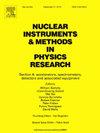用 120 GeV 质子对 SNSPD 进行束流测试
IF 1.5
3区 物理与天体物理
Q3 INSTRUMENTS & INSTRUMENTATION
Nuclear Instruments & Methods in Physics Research Section A-accelerators Spectrometers Detectors and Associated Equipment
Pub Date : 2024-10-09
DOI:10.1016/j.nima.2024.169956
引用次数: 0
摘要
我们报告了 120 GeV 质子束入射到不同线径的超导纳米线粒子探测器上的测试结果。我们用不同的线宽制造了具有相同敏感区域的氮化铌器件,并在 2.82 K 的温度下进行了测试。结果表明,线宽是决定探测效率的关键因素,线宽大于 400 nm 会导致低偏置电流下的低效率。这些结果与加速器设施(如电子-离子对撞机)的新型应用尤其相关,因为在加速器设施中可以随时进行低温冷却。本文章由计算机程序翻译,如有差异,请以英文原文为准。
Beam tests of SNSPDs with 120 GeV protons
We report the test results for a 120 GeV proton beam incident on superconducting nanowire particle detectors of various wire sizes. NbN devices with the same sensitive area were fabricated with different wire widths and tested at a temperature of 2.82 K. The relative detection efficiency was extracted from bias current scans for each device. The results show that the wire width is a critical factor in determining the detection efficiency and larger wire widths than 400 nm leads to inefficiencies at low bias currents. These results are particularly relevant for novel applications at accelerator facilities, such as the Electron-Ion Collider, where cryogenic cooling is readily available.
求助全文
通过发布文献求助,成功后即可免费获取论文全文。
去求助
来源期刊
CiteScore
3.20
自引率
21.40%
发文量
787
审稿时长
1 months
期刊介绍:
Section A of Nuclear Instruments and Methods in Physics Research publishes papers on design, manufacturing and performance of scientific instruments with an emphasis on large scale facilities. This includes the development of particle accelerators, ion sources, beam transport systems and target arrangements as well as the use of secondary phenomena such as synchrotron radiation and free electron lasers. It also includes all types of instrumentation for the detection and spectrometry of radiations from high energy processes and nuclear decays, as well as instrumentation for experiments at nuclear reactors. Specialized electronics for nuclear and other types of spectrometry as well as computerization of measurements and control systems in this area also find their place in the A section.
Theoretical as well as experimental papers are accepted.

 求助内容:
求助内容: 应助结果提醒方式:
应助结果提醒方式:


